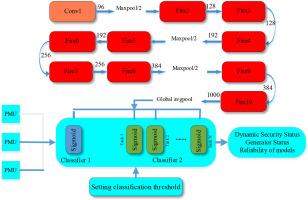基于不确定感知的双级多任务SqueezeNet的电力系统动态安全评估,重点研究小数据和不平衡数据下关键发电机的识别
IF 9.6
Q1 COMPUTER SCIENCE, ARTIFICIAL INTELLIGENCE
引用次数: 0
摘要
基于深度学习(DL)的故障前动态安全评估(DSA)方法在电力系统安全运行方面取得了重要成果。然而,电力系统经常受到数据集不足、小和不平衡的影响,这严重影响了基于dl的DSA模型的性能。现有的DSA框架通常作为两类黑盒模型运行,仅评估整体系统安全性,而没有提供对不安全原因的深入了解或识别关键生成器(cg),并且它们无法量化预测的不确定性。这些挑战阻碍了当前方法在实际电力系统中的实施,并降低了运营商对这些方法的信心。为了解决这些问题,本文提出了一种基于迁移学习和SqueezeNet架构的不确定性感知双级多任务学习框架。该框架评估系统安全性,识别不稳定期间的cg,并利用预训练的SqueezeNet模型进行微调,以促进有限数据的训练。此外,证据深度学习被纳入量化分类不确定性。该框架不依赖于复杂且具有挑战性的数据增强方法,而是使用一种称为最优分类阈值确定的简单技术来减轻不平衡数据对模型性能的负面影响。最佳阈值是通过使受试者工作特征(ROC)曲线下面积最大化来确定的。在IEEE 118总线系统中的应用表明,该方法具有良好的性能。这些结果为在现实世界的电力系统中实现基于dl的DSA提供了关键的技术见解。本文章由计算机程序翻译,如有差异,请以英文原文为准。

An uncertainty-aware bi-level multitask SqueezeNet for dynamic security assessment in power systems with focus on critical generator identification under small and imbalanced datasets
Deep learning (DL)-based methods in pre-fault dynamic security assessment (DSA) have provided significant results, contributing to the safe operation of power systems. However, power systems often suffer from insufficient, small, and imbalanced datasets, which significantly impact the performance of DL-based DSA models. Existing DSA frameworks typically operate as two-class black-box models, assessing only overall system security without providing insights into the causes of insecurity or identifying critical generators (CGs), and they fail to quantify prediction uncertainty. These challenges hinder the implementation of current methods in real-world power systems and reduce operators' confidence in them. To address these issues, this paper proposes an uncertainty-aware bi-level multitask learning framework based on transfer learning and SqueezeNet architecture. The framework assesses system security, identifies CGs during instability, and leverages fine-tuning of a pre-trained SqueezeNet model to facilitate training with limited data. Additionally, evidential deep learning is incorporated to quantify classification uncertainty. Without relying on the complex and challenging data augmentation method, this framework uses a simple technique called optimal classification threshold determination to mitigate the negative impact of imbalanced data on model performance. The optimal threshold is determined by maximizing the area under the receiver operating characteristic (ROC) curve. The application of the proposed method to the IEEE 118-bus system shows its strong performance. These results offer crucial technical insights for the implementation of DL-based DSA in real-world power systems.
求助全文
通过发布文献求助,成功后即可免费获取论文全文。
去求助
来源期刊

Energy and AI
Engineering-Engineering (miscellaneous)
CiteScore
16.50
自引率
0.00%
发文量
64
审稿时长
56 days
 求助内容:
求助内容: 应助结果提醒方式:
应助结果提醒方式:


